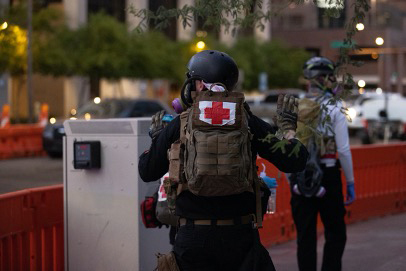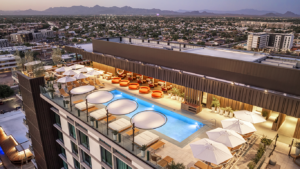Three nights after George Floyd suffocated when a white police officer in Minneapolis knelt on his neck for nearly nine minutes, Black Lives Matter supporters rallied in downtown Phoenix. From 7 p.m. to 2 a.m., hundreds of people were on the streets chanting, “What’s his name? George Floyd!” and “Hands up, don’t shoot!” Many held signs that read “Black Lives Matter” and “Silence is violence.”
Tensions rose that night, May 28, between protesters and the Phoenix Police Department, whose use of force made it the deadliest in the country in 2018, according to an analysis by the National Police Foundation.
Ashley Cuber, 25, a law student at Arizona State University, was there in a show of solidarity. About 11:30 p.m., after police declared the protest an illegal gathering, she said, she saw a police officer’s rubber bullet hit the skull of a teenage girl.
Cuber, a short woman who normally wears a black T-shirt with the words Desert Action Medical Network and a baseball cap with a red cross duct taped in the front, immediately put to use the EMT license she earned while living in Alaska, where she trained in wilderness first aid because help might not arrive in time if she were injured. As she and the wounded teenager ran from police wearing riot gear, Cuber tossed the teenager an ice pack and told her to go to the emergency room immediately. She suspected the girl’s skull was fractured.
“That’s all I could do. That’s probably the worst injury I’ve seen all summer,” said Cuber, adding that she didn’t see any street medics in the crowd of hundreds to treat protesters.
The next day, she went to Walmart and bought an olive-green backpack for $20 and filled it with a squirt bottle, saline solution, water, Band-Aids, sunscreen, glucose gel, electrolyte packets, tape, trauma shears, gloves and an extra change of clothes, ice packs and a first aid kit that contains everything she needs to stop the bleeding in case someone gets seriously injured. Cuber then used red and white duct tape to fashion an oversize red cross and slapped it on the backpack.
Although Cuber didn’t see them, there were others like her on the streets that night, people who realized the need for street medics to be on the sidelines of the protest, ready to act if violence broke out. They included a young man in his mid-20s who wears a camouflage armored vest, ballistic glasses and a black neck gaiter that covers most of his face.
The man, who calls himself Irish to protect his anonymity, said he was hanging out with some friends downtown and joined the crowd of protesters marching to Phoenix police headquarters at Washington and Seventh streets. When they arrived in front of the building, Irish said he saw officers in riot gear and metal barricades. Soon after, he said, he heard pop, pop, pop and saw a tear gas canister rolling on the pavement as protesters started coughing.
Irish put his hands up and walked toward the police, but then he felt the sharp pain of a rubber bullet hit his chin. He fell over and screamed for help because he was having a hard time breathing. He said he was engulfed by a cloud of tear gas until a group of strangers pulled him away.
“It was the first time I ever got tear-gassed,” he said. “Throughout the night, it turned into absolute chaos.”
Irish is trained in CPR, first aid and treating gunshot wounds. When he got home, he began preparing for the next day’s protest by reading “Riot Medicine,” a guide that provides a basic overview of medical care during civil unrest. That’s what got him ready to treat protesters who were dehydrated, tear-gassed and injured by pepper projectiles – which are similar to paintballs but filled with a powder version of the chemical irritant found in pepper spray.
On June 23, when Phoenix police shot flash-bang grenades and pepper projectiles at protesters after a Trump rally in north Phoenix, Cuber, Irish and six others – ranging from paramedics to people with basic first-aid knowledge – formed Desert Action Medical Network. Since then, these street medics have attended more than 80 protests in metro Phoenix, providing medical care to more than 60 people.
“All of us are massive Black Lives Matter supporters,” Cuber said, “and we’re all looking for a way that we can involve ourselves in the demonstrations this summer, and somehow medicine just became the best use of our skills for this movement. I wanted to do more than hold a sign.”
Almost every major city has a street medic organization that formed during times of civil unrest. Street medics can be traced back to Freedom Summer, a 1964 project that aimed to increase voter registration among Black Mississippians. Among the many white and Black college students from New York who went to Mississippi to challenge Jim Crow laws were those organized as the Medical Committee for Human Rights. The committee of doctors and nurses included people like Ann Hirschman, who wrote one of the earliest training programs for street medics.
In the Phoenix area, protests had dwindled by the end of July, but they were rising in Portland, Oregon, prompting the Trump administration to dispatch federal agents to the city. When Cuber, Irish and other medics found out about it, they reached out to other street medics to drum up trauma support. The group crowdsourced $900 to send Cuber, Irish, a paramedic and two emergency medical technicians to Portland. By the time they arrived July 29, violence had died down, and the White House that day announced the withdrawal of federal agents from the city’s downtown.
“We had no idea what to expect when we went there,” Cuber said.
The group carried backpacks weighing 15 to 60 pounds that included sturdy bike helmets, ballistic goggles, half-mask respirators and trauma gear, although they only ended up giving out some Band-Aids and treating a handful of people for heat-related illnesses.
“I wish I could have done more when they needed us more,” Irish said.
Tempe Chalk Walk, June 27
One of the most challenging nights Cuber said she has faced as a street medic was at a chalk-drawing event in front of Tempe Marketplace, which was organized by W.E. Rising Project, a new group that has been vocal about police violence in Phoenix. The event ended about 8 p.m.
Cuber said that as she, another street medic and a few protesters were walking to their cars, an unmarked car with red and blue flashing lights under the door panels sped up and stopped in front of them.
She said her first instinct was to run – “Oh my God, I’m going to get kidnapped” – but the protesters saw police in riot gear exiting 10 SWAT vehicles behind them.
As Tempe police officers were trying to arrest two people who allegedly prevented a Tempe Marketplace customer from exiting the parking lot while hitting and throwing items at the vehicle, Cuber said she and the others were shoved to the pavement. She said she hit her head as she fell.
In a video of the incident, the police officers started yelling for them to get up, but a woman who did was pushed back down. Ryan Tice, 22, can be heard shouting, “Do not push her” before he is pepper-sprayed by an officer.
According to Cuber, police-issued pepper spray is about three times more powerful than the pepper spray available for purchase by civilians. Cuber said Tice’s clothes and face were drenched in it.
In the video, police advise Tice to move back. He can be seen walking on the sidewalk as Irish, wearing an all-black outfit with red crosses taped to it, comes running to help. As officers keep telling Tice to move back, to get on the grass, Tice puts his hands to his face and says, “Officer, I can’t see!”
Irish said he was trying to unpack some of his gear to treat Tice, as Tice implored for help. Irish said he started shaking, which cost him time treating his patient.
“Just that voice of him saying, ‘Help me,’ kind of haunted me for quite a while, and even now it chokes me up,” Irish said, his voice cracking. “It’s just the fact of someone saying, ‘Help me, help me,’ and I’m right next to them and I couldn’t do my best at that moment. I have nightmares every once in a while about it.”
In response to the incident, Tempe police department’s public information officer Natalie Barela said none of the officers violated the department’s use of force policy, which states pepper spray may be used as an effective control method against violent or non-compliant subjects.
Blue Silence Rally, Aug. 9
That night, Cuber joined two dozen Black Lives Matter supporters outside the Phoenix Police Department for the Blue Silence Rally in honor of Michael Brown, 18, a Black man who had been killed by a white police officer in Ferguson, Missouri, on that day in 2014. As the protesters gathered on the street, a voice boomed over a megaphone: “This is Lieutenant Ben Moore, the Phoenix Police Department. You are obstructing a public thoroughfare. If you do not move yourself to the sidewalk, you will be subject to arrest.”
Those words, Cuber said, “repeat in my brain as I try to fall asleep.”
When protesters knocked down a metal barricade, she said, at least 30 police officers in riot gear swarmed them and fired flash grenades, rubber bullets, beanbag rounds and pepper projectiles.
Cuber and three other medics treated a man who was hit at least eight times with rubber bullets and beanbag rounds and coated with pepper spray. She said someone in their vicinity got angry and chucked a water bottle near where the police were standing – and officers fired directly at the medics.
“We all have red crosses, every single place – on our backpacks, hats, shirts, sleeves, even knee pads,” she said.
The medics grabbed the man who had been struck by rubber bullets and walked him to another area, Cuber said, and for the remainder of the protest, officers kept their weapons aimed at them.
“I got hit in the legs, another medic got hit everywhere,” she said.
Phoenix police department’s public information officer responded by email saying there was criminal activity and arrests were made. According to the department’s guidelines for public demonstrations, when officers wade into crowds of protesters to arrest specific individuals, officers use lawful measures to disperse the crowd.
So others may live
Desert Action Medical Network is known throughout the protest community these days and organizers say they act as a neutral group that is willing to provide medical assistance to anyone.
“As long as we’re wearing that red cross, we’re medics,” Irish said. “Unlike criminal justice in this country, as a medic, we should be unbiased in who we treat.”
Before the medics treat someone, Cuber said, they tell the injured person their names and qualifications, and let them know they work as volunteers. Tice said Cuber, Irish and the other street medics operate like a surgical team.
“They have probably saved at least one person’s life, if not mine, because I could have died from shock,” Tice said. “What they’re doing is probably the most important work that we have out there.”
One thing Cuber and the other medics feared was escalating violence from counter protesters in Gilbert, where, every Thursday for several weeks, those on the left and right of the political spectrum taunted each other on the corner of Gilbert and Warner roads. She worried that medics might someday have to treat someone for a gunshot or knife wound.
Cuber and her crew bought most of their medical equipment with their own money. If that incident does happen, the medics will be ready to assist anyone who needs help. Irish said he lives by a motto: “So others may live.”
“I have the ability, so I have the responsibility to be there,” he said. “If I’m not there that one day, that’s when something serious is going to happen – then I’ll have to live with that for the rest of my life knowing that I wasn’t there to help them when I could have.”
Story by Jonmaesha Beltran, Special for Cronkite News




